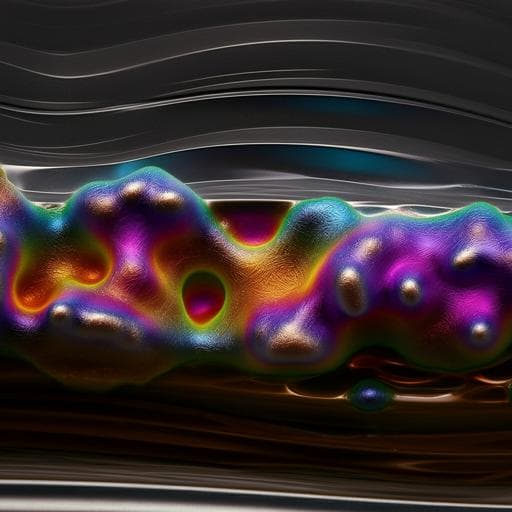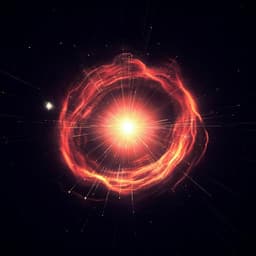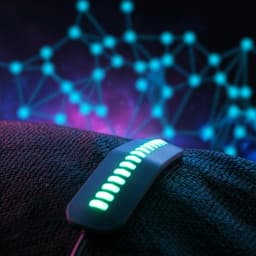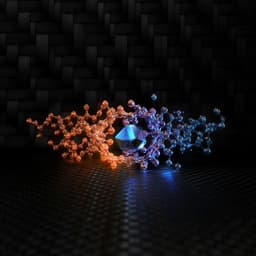
Physics
Dipolar skyrmions and antiskyrmions of arbitrary topological charge at room temperature
M. Hassan, S. Koraltan, et al.
This groundbreaking research by Mariam Hassan, Sabri Koraltan, and colleagues reveals the direct observation of dipolar skyrmions and antiskyrmions with varying topological charges in Co/Ni multilayers at room temperature. The study meticulously characterizes these unique spin objects, providing insights into their nucleation and stability crucial for future device innovations.
~3 min • Beginner • English
Introduction
This study investigates whether dipolar-stabilized magnetic skyrmions (SKs) and antiskyrmions (ASKs) with arbitrary integer topological charge Q can be realized and stabilized at room temperature in sputtered Co/Ni multilayers. Prior systems based on chiral interactions (Dzyaloshinskii-Moriya interaction) typically host mainly Q = −1 skyrmions and often require cryogenic temperatures and single-crystal growth, limiting scalability. Here, the authors aim to directly observe high-order (anti)skyrmions, quantify their energy and stability as a function of Q and external field, elucidate their nucleation mechanisms, map stability in terms of material parameters (saturation magnetization and anisotropy), and demonstrate current-driven dynamics relevant to devices.
Literature Review
Two main stabilization mechanisms for SKs exist: (1) short-range chiral interactions (exchange–Dzyaloshinskii–Moriya) that typically yield Q = −1 skyrmions and, in limited cases, high-Q bags/bundles; and (2) competition between long-range dipolar and short-range exchange interactions in thin films with perpendicular magnetic anisotropy (PMA), which can stabilize dipolar SKs at room temperature and are compatible with sputtered multilayers. Previous reports in dipolar systems include SKs (Q = −1), type-II bubbles (Q = 0), and ASKs (Q = +1), with rare observation of second-order ASKs (Q = +2) in Fe/Gd multilayers (sizes <200 nm). Classic bubble materials demonstrated large domain walls with vertical Bloch lines (VBLs) resembling Q = 2 ASKs but with sizes exceeding typical dipolar SKs and irregular shapes. High-Q textures in chiral magnets (SK bags/bundles) often require low temperatures and single crystals. Thus, a scalable, room-temperature platform hosting arbitrary Q is lacking; the dipolar Co/Ni multilayers investigated here address this gap.
Methodology
- Samples: Sputtered [Co(0.2 nm)/Ni(0.7 nm)]_n multilayers with n = 4–11 on Si/SiO2 substrates and 30-nm Si3N4 membranes (for LTEM). Pt(3 nm) seed and Si3N4(3 nm) cap; deposition at RT in UHV with Ar (3.5 µbar). Films exhibit PMA.
- Magnetic characterization: SQUID-VSM M–H loops at room temperature in out-of-plane (OOP) and in-plane (IP) geometries to determine M_s (~1000 kA/m). FMR with VNA in OOP configuration; Kittel fits (using known M_s) to extract uniaxial anisotropy K_u (650–750 kJ/m^3).
- LTEM imaging: JEOL NEOARM-200F, 200 keV, Fresnel mode (typical underfocus 2 mm). LTEM series for transport-of-intensity equation (TIE) reconstruction of magnetic induction maps, sensitive to in-plane components (Bloch-wall segments).
- Micromagnetic simulations: GPU-accelerated magnum.np finite-difference solver of LLG including exchange, demagnetization, uniaxial anisotropy, and external field; no DMI; no thermal noise (effective parameters at 300 K). Typical large box: 5000×5000×1 cells, 1×1×t nm^3 lateral discretization (t = total thickness). Example parameters: for n=5 (t=4.5 nm): M_s = 940 kA/m, K_u = 575 kJ/m^3, A = 10 pJ/m; for n=10 (t=9 nm): M_s = 1000 kA/m, K_u = 675 kJ/m^3, A = 10 pJ/m. Initialization with random magnetization; relax at zero field; then sweep OOP field (increase 1 mT/ns) to study nucleation and collapse. Contour-integral definition of Q using φ along soliton boundary (θ = π/2). Very fine lateral mesh (<2 nm) is required to resolve VBLs and higher-order textures.
- Stability mapping: Isolated objects (|Q| up to 6) relaxed in smaller boxes (300×300×1) while sweeping M_s and K_u (A constant) to map stability pockets (evaluated at fixed OOP field, e.g., 30 mT). Quality factor QF = K_u/(0.5 μ0 M_s^2) examined.
- Current-driven dynamics: Rectangular track 4096×1024×5 nm^3, cell 2×2×5 nm^3; parameters as for n=5, damping α=0.1. Zhang–Li spin-transfer torque with non-adiabaticity ζ=0.05 and b=72.17×10^−12. Initialize ASK/SK with Q = ±1, ±5; apply dc current density |j_e| = 2×10^11 A/m^2 under OOP bias B_ext = 25 mT for 100 ns; record trajectories and compute Skyrmion Hall angle θ_H (also evaluated for Q ∈ [−15, +15] and various J_c with 25 ns pulses).
- LTEM and induction simulations: Based on Beleggia–Zhu formalism for magnetic phase and Fresnel contrast; used to compare with experiments and visualize domain walls and VBLs.
Key Findings
- Direct observation at room temperature of dipolar-stabilized skyrmions (SKs, Q < 0), type-II bubbles (Q = 0), and antiskyrmions (ASKs, Q > 0) with arbitrary integer topological charge up to |Q| = 10 in sputtered Co/Ni multilayers.
- Coexistence of many (A)SK orders in the same film; typical diameters 200–500 nm, increasing with |Q| but remaining sub-micron; sizes tunable with OOP magnetic field.
- Spin structure: High-order textures are enclosed by a single domain boundary comprising alternating Bloch and Néel segments; VBLs in the boundary are crucial to nucleation and order setting. ASKs are predominantly circular (increasing elongation with Q), while high-order SKs (Q ≤ −3) appear as circular or elongated chains (e.g., elongated Q = −5 seen experimentally and in simulations).
- Energetics: Self-energy E_(A)SK vs OOP field shows high-order (A)SKs typically have higher energy than the saturated ferromagnet; at fixed field (e.g., μ0H|| = 15 mT) energy increases nearly linearly with |Q|. Dipolar high-order SKs and ASKs have nearly identical energies for the same |Q|, and differences diminish with increasing |Q|.
- Nucleation mechanisms: High-order (A)SKs form from shrinking domain walls containing multiple VBLs as OOP field increases. The number and arrangement of VBLs/domain-wall segments set the resulting Q. Not all VBL-containing walls nucleate higher-order objects; some vanish. Field-driven collapse of high-order SKs proceeds in steps (e.g., Q = −7 → −5 → −3 → −1), with even-Q elongated SKs becoming circular at higher fields; experimentally observed transformations include ASK Q = +4 reducing to SK Q = −1 upon further field increase.
- Stability phase diagram: Micromagnetics identifies a pocket of parameters where high-order (A)SKs up to |Q| ≈ 6 are stable around quality factor K_u/(0.5 μ0 M_s^2) ≈ 0.9–1.3, peaking near ≈1. Experimental Co/Ni multilayers (M_s ~1000 kA/m; K_u ~650–750 kJ/m^3) lie within this pocket.
- Current-driven motion: Simulations show translational motion with rotation toward steady-state trajectories under spin-transfer torque. The Skyrmion Hall angle θ_H is largest for Q = ±1 and strongly diminishes with increasing |Q| (evaluated up to |Q| = 15 and across current densities), indicating higher-order textures can mitigate the Skyrmion Hall effect. Example conditions: j = 2×10^11 A/m^2, OOP bias 25 mT, pulse 100 ns.
- Materials and metrology: LTEM directly images Bloch components and VBLs; induction maps from TIE and simulations corroborate texture identity and symmetry. SQUID-VSM confirms PMA and M_s ~1000 kA/m; FMR-derived K_u ~650–750 kJ/m^3.
Discussion
The work demonstrates that dipolar interactions in sputtered Co/Ni multilayers provide a scalable, room-temperature platform for stabilizing and coexisting skyrmions and antiskyrmions with arbitrary topological charge, overcoming key limitations of chiral-magnet platforms (temperature and crystal growth). The observed linear-like energy scaling with |Q| and near-degeneracy of SK/ASK energies for the same |Q| differ from chiral systems and suggest rich, symmetric dipolar energetics. Nucleation from VBL-rich domain walls elucidates how additional Bloch/Néel iterations encode higher Q, offering routes for deterministic formation via domain-wall engineering. The mapping of stability versus M_s and K_u highlights a practical quality-factor window for device-oriented materials design. Crucially, current-driven dynamics indicate that increasing |Q| reduces the Skyrmion Hall angle, addressing a major hurdle for racetrack-type devices. Together, these findings answer the central question by confirming room-temperature stability and controllability of arbitrary-Q dipolar (anti)skyrmions, with immediate implications for information technologies and unconventional computing.
Conclusion
The authors report the first direct observation (to their knowledge) of high-order dipolar skyrmions and antiskyrmions with Q up to 10 at room temperature in sputtered Co/Ni multilayers. They establish nucleation pathways via VBL-rich domain walls, quantify energy scaling with topological charge, and delineate a stability pocket around K_u/(0.5 μ0 M_s^2) ≈ 1. Micromagnetic simulations of spin-transfer-torque-driven motion reveal that the Skyrmion Hall angle markedly decreases with increasing |Q|, suggesting higher-order textures are advantageous for device transport. This accessible materials platform broadens fundamental exploration of topological charge and opens opportunities in skyrmionics, including racetrack memories and reservoir computing. Future research directions include deeper theoretical analysis of energetics and transformation pathways of high-order (A)SKs, experimental control of VBLs to deterministically set Q, improved imaging/classification of ambiguous textures, and integration into prototype devices to exploit reduced Hall angles and multi-state functionalities.
Limitations
- LTEM sensitivity favors Bloch components; certain observed spin objects could not be uniquely classified from LTEM contrast alone, leading to ambiguities for some textures.
- Samples with low repetition numbers (n = 4–5) exhibited weak LTEM contrast, limiting analysis.
- Micromagnetic simulations neglect explicit thermal fluctuations (use effective RT parameters) and assume quasi-2D homogeneity along thickness; while validated, this is an approximation.
- Accurate stabilization of higher-order textures requires very fine lateral discretization (<2 nm) to resolve VBLs; coarser meshes destabilize high-Q states.
- Nucleation outcomes depend on initial magnetic disorder and field history; starting from saturated states without defects yields few or no VBLs and may suppress nucleation of high-order objects.
- Some high-|Q| states collapse to lower Q at elevated fields; operational field windows are finite and order dependent.
Related Publications
Explore these studies to deepen your understanding of the subject.







